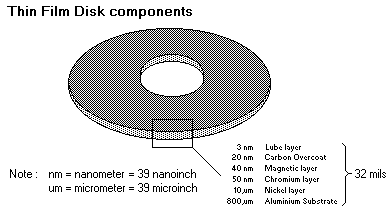
Media Manufacturing
An ideal storage disk will have no imperfections and store data for an indefinite amount of time.
The latter is theoretically achievable with today's magnetic materials assuming the environment
within the HDA does not change - that there is no contamination or malfunction of components
within the disk enclosure.
The former is not possible today but is often manageable.
The data is recorded onto the disk from signals emanating from the head transducer. A recorded
region is called a bit cell. For an areal density of 1Gb/sq inch, the size of a bit cell is 1 billionth
of a square inch. A 3.5-Inch - 1Gb/sq. inch disk can have in excess of 4 billion bit cells per surface.
In order to achieve these staggering numbers, strict manufacturing processes and advances in
magnetic materials are required.
A disk is defined as a thin film medium. That is multiple thin film layers of various materials are
deposited onto the disk through a sputtering process. The general structtire of a disk is shown
below. The substrate on which the magnetic and other materials are deposited is always
aluminum for 3.5-Inch HDD's (glass substrates are used for 2.5-Inch drives to improve shock characteristics).
Prior to material deposition which is performed in a clean room environment, the aluminum
substrate is machined sized and ground to an acceptable finish. As can be seen in the diagram
multiple layers of various materials are required to manufacture disks.

Please see the LEGAL - Trademark notice.
Feel free - send a  for any BUG on this page found - Thank you.
for any BUG on this page found - Thank you.